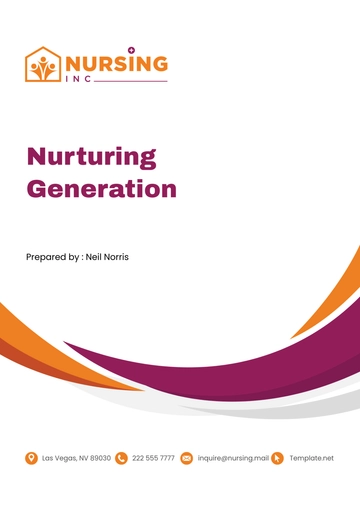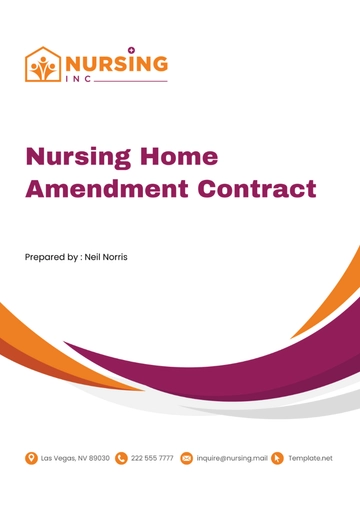Free Nursing Home Investment Contract

I. The Parties
This Nursing Home Investment Contract (hereinafter referred to as the “Contract”) is entered into on [Month Day, Year] (hereinafter referred to as the “Effective Date”). The parties involved in this Contract are:
A. The Company
[Your Company Name], a reputable and established entity in the nursing home industry, with its head office located at [Your Company Address]. For the purposes of this Contract, it will be referred to as the “Company”.
B. The Investor
[Investor’s Name], with a registered address at [Investor’s Address], is an individual or entity interested in investing in the nursing home industry. For the purposes of this Contract, [Investor’s Name] will be referred to as the “Investor”
collectively referred to as the "Parties".
WHEREAS, the Company is recognized for its expertise in the operation and management of nursing homes, providing quality care and services to its residents.
WHEREAS, the Investor has expressed interest in investing in the nursing home industry and recognizes the potential for growth and development in this sector.
WHEREAS, the Parties have mutually agreed to enter into this Contract, with the Investor providing capital for the growth and development of the Company’s nursing home operations.
NOW, THEREFORE, in consideration of the mutual covenants contained herein and for other good and valuable consideration, the receipt and sufficiency of which is hereby acknowledged, the Parties agree as follows:
II. Representations and Warranties
A. Execution and Delivery
Authorization: Each party assures that they have obtained all necessary approvals and consents for the execution and delivery of this agreement. This includes approvals from any internal bodies, such as a board of directors, or any external bodies, if required.
Validity: Each party confirms that the execution and delivery of this agreement do not violate any laws, regulations, or agreements to which they are subject.
Binding Effect: Each party acknowledges that upon execution and delivery, this agreement constitutes a legal, valid, and binding obligation.
B. Performance of Obligations
Capability: Each party represents that they have the necessary capabilities, resources, and expertise to perform their obligations under this agreement.
Compliance with Laws: Each party assures that in performing their obligations, they will comply with all applicable laws, regulations, and standards.
No Conflict: Each party confirms that their performance of obligations under this agreement does not and will not conflict with any other obligations they may have.
C. Enforceability
Legal Agreement: Each party confirms that this agreement is a legal agreement that is enforceable in accordance with its terms.
Jurisdiction: Each party acknowledges that any disputes arising from this agreement will be subject to the jurisdiction of the courts specified in this agreement.
Remedies: Each party understands that in the event of a breach of this agreement, the other party has the right to seek appropriate legal remedies.
Survival of Representations: Each party agrees that their representations and warranties shall survive the termination of this agreement.
Indemnification: Each party agrees to indemnify and hold harmless the other party from any damages, losses, or expenses arising from a breach of these representations and warranties.
Notification of Breach: Each party agrees to promptly notify the other party in the event of a breach of these representations and warranties.
III. Terms of Investment
A. Investment Amount
Amount: The Investor agrees to invest a sum of [$1,000,000] in the Company’s nursing home project. This amount has been mutually agreed upon by both parties.
Payment Method: The Investment Amount will be transferred to the Company’s designated account in a manner agreed upon by both parties.
Receipt of Investment: The Company acknowledges that it will confirm receipt of the Investment Amount and provide a receipt to the Investor.
B. Investment Term
Term Duration: The Investment Term is for a period of [5] years, commencing from the Effective Date of this Contract.
End of Term: At the end of the Investment Term, the Company agrees to return the Investment Amount to the Investor, unless otherwise agreed in this Contract.
Extension of Term: Any extension of the Investment Term will be subject to mutual agreement between the Parties and will require an amendment to this Contract.
C. Use of Investment
Purpose of Investment: The Company agrees to use the Investment Amount solely for the purpose of the nursing home project as outlined in the mutual agreement.
Management of Funds: The Company will manage the funds responsibly and in the best interest of the nursing home project.
Reporting: The Company will provide the Investor with regular updates on the progress of the nursing home project and the use of the Investment Amount.
Restrictions: The Company will not use the Investment Amount for any purpose not specified in this Contract without the prior written consent of the Investor.
Audit Rights: The Investor has the right to audit the Company’s use of the Investment Amount to ensure compliance with this Contract.
Breach of Contract: If the Company uses the Investment Amount for purposes not agreed upon, it will be considered a breach of this Contract and the Investor may take appropriate legal action.
IV. Profit Sharing
A. Calculation of Profit
Determination of Net Profit: The net profit will be calculated as the total revenue generated by the nursing home project minus all applicable expenses and taxes. This calculation will be done in accordance with standard accounting principles to ensure accuracy and fairness.
Financial Year Consideration: The financial year will be considered from [Month Day, Year] to [Month Day, Year], in line with the standard financial year observed in many jurisdictions. This ensures that the calculation of profit aligns with standard business practices.
Audit of Financial Statements: The Company’s financial statements, including the calculation of net profit, will be audited by an independent, certified public accountant. This audit will provide an additional layer of assurance regarding the accuracy of the financial statements.
B. Profit Sharing Percentage
Agreed Percentage: The Company agrees to share [20%] of the net profit generated by the nursing home project with the Investor. This percentage has been mutually agreed upon by both parties after careful consideration.
Calculation of Profit Share: The profit share will be calculated by applying the Profit Percentage to the net profit for the financial year. This calculation will be done at the end of each financial year.
Adjustments to Profit Percentage: Any adjustments to the Profit Percentage must be mutually agreed upon by both Parties and documented in a written amendment to this Contract. This ensures that any changes to the profit sharing arrangement are properly documented and agreed upon by both parties.
C. Payment of Profit Share
Timing of Payment: The Company agrees to remit the Investor’s share of the profit within [30] days of the end of the financial year. This ensures that the Investor receives their share of the profit in a timely manner.
Method of Payment: The payment will be made via a method agreed upon by both Parties, such as bank transfer or check. This ensures that the payment method is convenient for both parties.
Receipt of Payment: Upon payment, the Company will provide the Investor with a receipt or payment confirmation. This serves as proof of payment and can be used for record-keeping purposes.
D. Reporting and Transparency
Provision of Annual Report: The Company will provide the Investor with an annual report detailing the financial performance of the nursing home project. This report will include information about revenues, expenses, net profit, and the calculation of the Investor’s profit share.
Access to Financial Records: The Investor will have the right to access the financial records related to the nursing home project for the purpose of verifying the calculation of the net profit. This ensures transparency and allows the Investor to independently verify the financial results.
Resolution of Discrepancies: In case of any discrepancies in the calculation of the net profit or the Profit Percentage, the Parties agree to resolve the issue amicably through discussion or, if necessary, through the dispute resolution process outlined in this Contract.
Confidentiality of Financial Information: Both Parties agree to maintain the confidentiality of the financial information shared under this Contract. This protects sensitive financial information and prevents unauthorized disclosure.
Compliance with Laws and Regulations: The Company will ensure that all financial reporting and profit sharing practices comply with applicable laws and regulations. This ensures that the Company operates in a lawful and ethical manner.
Tax Obligations: Each Party will be responsible for their own tax obligations arising from the profit sharing arrangement. This ensures that each party fulfills their tax responsibilities in accordance with applicable laws.
V. Confidentiality
A. Scope of Confidentiality
Definition of Confidential Information: Confidential information includes, but is not limited to, all information related to this contract, the associated business operations, financial data, strategies, business plans, and any other information that is not publicly available.
Protection of Confidential Information: Both parties agree to take all reasonable measures to protect the confidentiality of the information and to prevent any unauthorized access, use, or disclosure.
Exclusions: Information that is already in the public domain, lawfully obtained from a third party, or independently developed without reference to the confidential information, is not considered confidential.
B. Disclosure of Confidential Information
Written Consent: Any disclosure of confidential information to third parties requires the prior written consent of the party to whom the information pertains.
Mandatory Disclosure: If a party is required by law, regulation, or a valid legal process to disclose confidential information, it should promptly notify the other party and cooperate with it to seek a protective order or other appropriate remedy.
Limited Disclosure: Any permitted disclosure of confidential information should be limited to the extent necessary. The receiving party must protect the confidentiality of the disclosed information.
C. Consequences of Breach
Breach of Contract: Any unauthorized access, use, or disclosure of confidential information is considered a breach of this contract.
Remedies: The aggrieved party has the right to seek all available legal remedies, including injunctive relief and damages.
Indemnification: The party responsible for the unauthorized access, use, or disclosure agrees to indemnify the aggrieved party for any losses, damages, or expenses resulting from the breach.
D. Duration of Confidentiality Obligation
Term: The obligation to maintain confidentiality will continue even after the termination of this contract, for a period agreed upon by both parties.
Survival of Clause: This confidentiality clause will survive the termination or expiration of this contract.
Return or Destruction of Confidential Information: Upon termination or expiration of this contract, each party agrees to return or destroy all confidential information received from the other party, unless otherwise agreed.
Audit Rights: Each party has the right to audit the other party’s compliance with this confidentiality clause.
Notification of Breach: Each party agrees to promptly notify the other party in the event of a breach of this confidentiality clause.
VI. Limitation Of Liability
A. Definition of Liability
Scope of Liability: Liability under this Contract refers to any legal responsibility for the losses or damages suffered by the other party. This means that if a party fails to fulfill their obligations under the Contract, they may be held responsible for any resulting losses or damages.
Limitation: The liability of each party is limited to the extent of their control. This means that neither party is responsible for losses or damages resulting from circumstances beyond their reasonable control. These circumstances can include natural disasters, power failures, labor disputes, actions of government authorities, war, or other disturbances.
Examples of Limitations: These circumstances can include natural disasters (acts of God), inclement weather, power failures, labor disputes, actions of government authorities, war, or other disturbances. These are events that are unpredictable and beyond the control of either party.
B. Exclusion of Liability
Force Majeure: In the event of a Force Majeure, neither party will be held liable for any failure or delay in performance of their obligations. This means that if a party is unable to fulfill their obligations due to an event beyond their control, they will not be held responsible for any resulting losses or damages.
Unforeseeable Circumstances: Neither party will be held liable for any loss or damage resulting from unforeseeable circumstances beyond their control. This includes, but is not limited to, acts of government, disruptions in telecommunications, or disturbances such as war or riots. These are events that are unpredictable and beyond the control of either party.
No Fault: If a party is not at fault for the loss or damage suffered by the other party, they will not be held liable. This means that a party will not be held responsible for losses or damages that were not caused by their actions or omissions.
C. Mitigation of Damages
Duty to Mitigate: Both parties agree to take reasonable steps to mitigate any loss or damage they may suffer as a result of events beyond the other party’s control. This means that both parties will make efforts to minimize the impact of any losses or damages resulting from unforeseeable events.
Cooperation: The parties agree to cooperate with each other in good faith to minimize the impact of any such events. This means that both parties will work together to manage the situation and minimize any resulting losses or damages.
Notification: The party affected by an event beyond the other party’s control agrees to promptly notify the other party and provide details of the event and its impact. This ensures that both parties are aware of the situation and can take appropriate steps to manage it.
D. Legal Remedies
Legal Action: If a party suffers loss or damage as a result of the other party’s breach of this Contract, they have the right to take legal action. This means that the aggrieved party can seek legal remedies, such as damages or an injunction, to compensate for their losses or prevent further harm.
Compensation: The party at fault may be required to compensate the other party for their loss or damage, subject to the limitations set out in this Contract. This means that the party responsible for the breach may be required to pay damages to compensate the aggrieved party for their losses.
Survival of Clause: This limitation of liability clause will survive the termination or expiration of this Contract. This means that the parties will continue to be bound by this clause even after the Contract has ended.
VII. Termination
A. Notice of Termination
Requirement for Written Notice: Either party may terminate this Contract by providing a written notice to the other party. This ensures that the intention to terminate the Contract is clearly communicated.
Termination Notice Period: The notice must be provided at least [30] days before the intended date of termination. This gives both parties sufficient time to wrap up any pending matters related to the Contract.
Receipt of Notice: The party receiving the termination notice must acknowledge receipt in writing. This ensures that the notice has been received and understood.
B. Obligations upon Termination
Fulfillment of Obligations: Upon receipt of the termination notice, both parties should take steps to fulfill any outstanding obligations under the Contract. This includes, but is not limited to, the payment of any outstanding amounts and the completion of any ongoing tasks.
Return of Property: If either party has any property belonging to the other party, they must arrange for its return upon termination of the Contract.
Confidentiality: The termination of the Contract does not relieve either party of their obligations under the confidentiality clause. Both parties must continue to protect any confidential information received during the term of the Contract.
C. Consequences of Termination
Release from Obligations: Upon termination of the Contract, and subject to the fulfillment of any outstanding obligations, both parties are released from their obligations under the Contract.
Survival of Certain Clauses: Certain clauses of the Contract, such as the confidentiality clause will survive the termination of the Contract. This means that both parties must continue to abide by these clauses even after the termination of the Contract.
Final Settlement: Upon termination of the Contract, a final settlement will be conducted. This includes the calculation and payment of any outstanding amounts.
Record Keeping: Both parties must keep a record of the termination and the final settlement for a period agreed upon in the Contract.
Regulatory Compliance: Both parties will ensure that the termination of the Contract complies with all applicable laws and regulations.
Notification of Breach: Each party agrees to promptly notify the other party in the event of a breach of this termination clause.
VIII. Governing Law
A. Validity of the Agreement
Legal Compliance: The agreement has been drafted in compliance with the laws of the [State Name]. This ensures that the agreement is legally valid and enforceable.
Enforceability: The enforceability of the agreement is subject to the Governing Law. This means that any disputes arising from the agreement will be resolved in accordance with the laws of the [State Name].
Legal Jurisdiction: The courts of the [State Name] will have jurisdiction over any legal proceedings related to the agreement. This ensures that any legal disputes will be resolved in a court familiar with the Governing Law.
B. Construction of the Agreement
Interpretation: The interpretation of the terms and conditions of the agreement will be done in accordance with the Governing Law. This ensures that the agreement is interpreted consistently and fairly.
Resolution of Ambiguities: In case of any ambiguities in the agreement, they will be resolved in accordance with the Governing Law. This ensures that any unclear terms or conditions are clarified based on the legal principles of the [State Name].
Amendments: Any amendments to the agreement must be in compliance with the Governing Law. This ensures that any changes to the agreement are legally valid.
C. Performance of the Agreement
Fulfillment of Obligations: The parties’ fulfillment of their obligations under the agreement will be assessed based on the Governing Law. This ensures that the parties’ actions are evaluated against the legal standards of the [State Name].
Breach of Agreement: In case of a breach of the agreement, the remedies will be determined based on the Governing Law. This ensures that any penalties or damages awarded are in line with the legal principles of the [State Name].
IX. Entire Agreement
A. Completeness of the Contract
Inclusive Nature: This Contract is comprehensive and includes all terms, conditions, and provisions agreed upon by the parties. It represents the complete understanding between the parties regarding the subject matter.
Superseding Effect: This Contract supersedes any and all prior agreements, whether oral or written, between the parties relating to the subject matter of this Contract. This means that any previous understandings or arrangements that are not included in this Contract are no longer in effect.
Exclusion of Other Agreements: No other agreements, representations, warranties, or other matters, oral or written, will be deemed to bind the parties, except as expressly provided in this Contract.
B. Modifications to the Contract
Written Amendments: Any modifications or amendments to this Contract must be in writing and signed by both parties. This ensures that any changes to the Contract are documented and mutually agreed upon.
No Oral Modifications: Oral modifications to this Contract are not valid. This protects both parties from misunderstandings or disputes about verbal changes to the Contract.
Record of Amendments: All amendments to this Contract will be recorded and attached to the Contract. This provides a clear record of all changes made to the Contract.
C. Interpretation of the Contract
Consistent Interpretation: This Contract should be interpreted in a manner that is consistent with the intentions of the parties as expressed in the Contract. This ensures that the Contract is understood in the way that the parties intended.
Resolution of Discrepancies: If there is any discrepancy between this Contract and any prior agreements, the terms of this Contract will prevail. This ensures that the most recent agreement between the parties is the one that is followed.
Legal Guidance: If there are any uncertainties or disputes about the interpretation of this Contract, the parties agree to seek legal advice. This ensures that the Contract is interpreted in accordance with the law.
X. Signatures
By signing below, the parties hereby confirm their understanding and acceptance of the terms stated above.
Company

[Authorized Representative Name]
[Your Company Name]
Date: [Month Day, Year]
Investor

[Investor's Name]
Date: [Month Day, Year]
- 100% Customizable, free editor
- Access 1 Million+ Templates, photo’s & graphics
- Download or share as a template
- Click and replace photos, graphics, text, backgrounds
- Resize, crop, AI write & more
- Access advanced editor
Ensure nursing home investments are binding with the Nursing Home Investment Contract Template available only on Template.net! This customizable solution formalizes investment agreements and arrangements. Make use of the editable fields to outline investment terms and conditions. The AI Editor Tool streamlines contract customization, protecting nursing home financial interests effectively!
You may also like
- Rental Contract
- Contractor Contract
- Contract Agreement
- One Page Contract
- School Contract
- Social Media Contract
- Service Contract
- Business Contract
- Restaurant Contract
- Marketing Contract
- Real Estate Contract
- IT Contract
- Cleaning Contract
- Property Contract
- Supplier Contract
- Partnership Contract
- Food Business Contract
- Construction Contract
- Employment Contract
- Investment Contract
- Project Contract
- Payment Contract
- Student Contract
- Travel Agency Contract
- Startup Contract
- Annual Maintenance Contract
- Employee Contract
- Gym Contract
- Event Planning Contract
- Personal Contract
- Nursing Home Contract
- Law Firm Contract
- Work from Home Contract
- Software Development Contract
- Maintenance Contract
- Music Contract
- Amendment Contract
- Band Contract
- DJ Contract
- University Contract
- Salon Contract
- Renovation Contract
- Photography Contract
- Lawn Care Contract


























